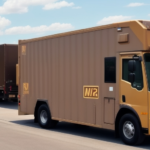How to Calculate Shipping Costs Easily
In business, shipping costs are a significant factor that can affect the overall profitability of your company. Calculating shipping costs accurately helps you make informed decisions about pricing, inventory management, and shipping solutions. In this article, we’ll discuss how to calculate shipping costs easily and provide insightful tips and tools to help you save money on shipping.
Understanding Shipping Costs and Their Importance
Shipping costs are the expenses associated with moving goods from one location to another. These costs are determined by various factors, such as the weight and size of the item, shipping method, distance, and destination. Understanding shipping costs is crucial because they directly impact your bottom line. If you price your products too low, you might lose money on shipping costs. Conversely, charging too much can drive customers to competitors offering better shipping rates.
Moreover, shipping costs can significantly influence customer satisfaction. Customers expect fast and affordable shipping, and if they perceive shipping as overcharged or delayed, it may result in negative reviews or reduced customer loyalty. Offering free shipping or discounts can be effective strategies to attract and retain customers. Therefore, comprehensively understanding and optimizing shipping costs can improve both profitability and customer satisfaction.
Key Factors Influencing Shipping Costs
Several elements can affect shipping costs, including:
- Package Weight and Dimensions: Heavier and larger packages typically cost more to ship.
- Shipping Method: Ground, air, sea, and expedited shipping options vary in cost and delivery time.
- Distance and Destination: Longer distances and remote destinations often increase shipping costs.
- Additional Services: Services like insurance, tracking, and signature confirmation can add to the overall cost.
- Carrier Fees: Different carriers have varied pricing structures, including fees for residential delivery, rush orders, or oversized items.
The shipping distance plays a significant role; the farther the destination, the higher the cost due to increased fuel and labor expenses. Shipping to remote areas may also incur additional charges due to limited transportation options.
Timing affects costs as well. Shipping during peak seasons like holidays can lead to higher costs due to increased demand. On the contrary, off-peak shipping may benefit from lower rates as carriers may offer discounts to encourage shipping during slower periods.
Common Shipping Methods and Cost Implications
Businesses have access to multiple shipping methods, each with its own cost and delivery time implications:
- Ground Shipping: Generally the most cost-effective option for domestic shipments but slower compared to air or express shipping.
- Air Shipping: Faster deliveries, ideal for urgent shipments, but more expensive.
- Sea Shipping: The most economical for international large-volume shipments, though with longer transit times.
- Expedited Shipping: Offers quicker delivery times but at a premium cost.
It's essential to consider not just the cost but also the environmental impact of your chosen shipping method. For instance, air shipping has a higher carbon footprint compared to ground or sea shipping. If sustainability is a priority, opting for more eco-friendly shipping options, even if slightly more expensive, can align with your business values and customer expectations.
Strategies for Reducing Shipping Costs
There are several effective strategies to minimize shipping expenses without compromising service quality:
Consolidate Shipments
By consolidating multiple orders into a single shipment, you can reduce per-unit shipping costs and take advantage of bulk shipping discounts.
Optimize Packaging
Use appropriately sized packaging to decrease dimensional weight charges. Investing in lightweight but sturdy packaging materials can also contribute to cost savings.
Use Flat-Rate Shipping Options
Flat-rate shipping, offered by carriers like USPS, allows you to ship packages at a fixed rate regardless of weight or distance, potentially saving money on larger or heavier items.
Leverage Fulfillment Centers
Partnering with fulfillment centers can reduce shipping costs by taking advantage of their negotiated shipping rates and streamlined logistics processes.
Regularly Review and Analyze Shipping Expenses
Monitor your shipping expenses periodically to identify areas where you can negotiate better rates or streamline your shipping processes.
Negotiating with Carriers and Suppliers for Better Rates
Negotiating favorable rates with your shipping carriers and suppliers can lead to significant cost savings:
Research and Compare Carriers
Evaluate different carriers based on their rates, services, and reliability to determine the best fit for your business needs.
Build Strong Relationships
Establishing good relationships with your carriers can lead to better negotiation outcomes and tailored solutions to meet your shipping requirements.
Leverage Shipping Volume
If your shipping volume is substantial, use it as leverage to negotiate discounts or preferential rates with carriers.
Stay Informed on Industry Trends
Understanding current trends and regulatory changes in the shipping industry can provide an advantage during negotiations, enabling you to anticipate and mitigate potential cost increases.
Essential Tools and Technologies for Shipping Cost Calculation
Several tools and technologies can assist businesses in accurately calculating shipping costs:
- Online Shipping Calculators: Many carriers offer online tools to estimate shipping costs based on package specifications and destination.
- Third-Party Shipping Software: Platforms like ShipStation, Shippo, and Easyship integrate with various carriers to provide real-time shipping rates and streamline label generation.
- Dimensional Weight Calculators: These tools calculate shipping costs based on both the size and weight of packages, ensuring accurate pricing.
- Shipping Software Integration: Software like Stamps.com or Endicia can integrate directly with e-commerce platforms to automate shipping cost calculations and label printing.
By utilizing these tools, businesses can save time, reduce errors, and ensure that they are charging appropriate shipping fees to cover costs.
Future Trends in Shipping Cost Management
As technology evolves, so do the methods for managing and optimizing shipping costs:
Automation and AI
Automation tools and artificial intelligence can streamline shipping processes, predict shipping costs more accurately, and optimize route planning to reduce expenses.
Sustainability
With increasing consumer demand for environmentally responsible practices, businesses are moving towards more sustainable shipping options, such as carbon-neutral shipping or using eco-friendly packaging materials.
Integration of Advanced Analytics
Advanced data analytics can provide deeper insights into shipping patterns and costs, enabling more informed decision-making and cost optimization strategies.
Enhanced Carrier Partnerships
Businesses are forming more strategic partnerships with carriers to secure better rates, improve service levels, and integrate logistical processes more seamlessly.
Conclusion
Calculating shipping costs accurately is vital for maintaining profitability and customer satisfaction in any business. By understanding the key factors that influence shipping costs, employing effective strategies to reduce expenses, leveraging essential tools and technologies, and staying ahead of future trends, businesses can optimize their shipping operations. Implement these practices to ensure you are managing your shipping costs efficiently, thus contributing to the overall success and competitiveness of your business.






















